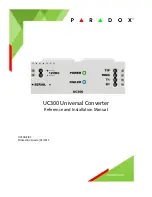
Section 2 Direct Excitation (Brush Type)
Diagnostic Repair Manual
19
Results
1.
If unit is overloaded, reduce load.
2.
If load is within limits but frequency and voltage still
drop excessively, refer to flow chart.
Overloading a generator in excess of its rated wattage
capacity can result in damage to the generator and to
connected electrical devices. Observe the following to
prevent overloading unit:
•
Add up total wattage of all electrical devices to be
connected at one time. This total should NOT be
greater than the generator's wattage capacity.
•
The rated wattage of lights can be taken from light
bulbs. The rated wattage of tools, appliances and
motors can be found on a data label or decal
affixed to the device.
•
If the appliance, tool or motor does not give
wattage, multiply volts times ampere rating to
determine watts (volts x amps = watts).
•
Some electric motors, such as induction types,
require about three times more watts of power for
starting than for running. This surge of power lasts
only a few seconds when starting such motors.
Make sure to allow for high starting wattage when
selecting electrical devices to connect to the generator:
1.
Figure watts needed to start the largest motor.
2.
Add to that figure the running watts of all other
connected loads.
Test 12 – Adjust Voltage Regulator
NOTE:
Always use the unit specific schematics and
wiring diagrams for brush orientation.
Procedure
1.
Remove cover from end of alternator assembly.
2.
Remove two screws holding the voltage regulator
(AVR) to the bearing carrier.
3.
Leave AVR connected to stator and brushes.
4.
Set DMM to measure AC voltage.
5.
See
. Connect DMM across a 240VAC
socket.
Figure 1-10. DMM Test Leads Connected to a 240
VAC Receptacle
6.
Ensure all material is clear of the alternator before
proceeding.
7.
Set START-STOP-RUN switch to START.
8.
for location of adjustment screw.
9.
Adjusting screw clockwise will increase voltage,
adjusting counterclockwise will lower voltage.
Results
1.
If there is no change in voltage while adjusting,
refer back to the flow chart.
2.
If voltage is correct, stop testing.
*Compressor (1 HP)
2000
Oil Fired Space Heater (85,000 Btu)
225
*Compressor (3/4 HP)
1800
Oil Fired Space Heater (30,000 Btu)
150
*Compressor (1/2 HP)
1400
*Paint Sprayer, Airless (1/3 HP)
600
Curling Iron
700
Paint Sprayer, Airless (hand held)
150
*Dehumidifier
650
Radio
50 to 200
Disc Sander (9")
1200
*Refrigerator
700
Edge Trimmer
500
Slow Cooker
200
Electric Blanket
400
*Submersible Pump (1-1/2 HP)
2800
Electric Nail Gun
1200
*Submersible Pump (1 HP)
2000
Electric Range (per element)
1500
*Submersible Pump (1/2 HP)
1500
Electric Skillet
1250
*Sump Pump
800 to 1050
*Freezer
700
*Table Saw (10")
1750 to 2000
*Furnace Fan (3/5 HP)
875
Television
200 to 500
*Garage Door Opener
500 to 750
Toaster
1000 to 1650
Hair Dryer
1200
Weed Trimmer
500
* Allow 3 times the listed watts for starting these devices.
240
















































